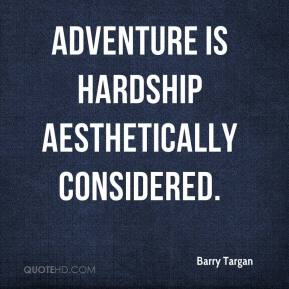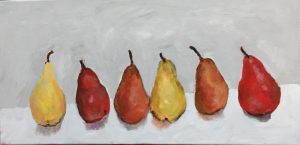
 An artist is “a person who produces works in any of the arts that are primarily subject to aesthetic criteria.” If this definition is true, then I am not sure what Barry Targan is. He produces work in MANY of the arts, not just ANY. If you have seen Barry’s work at VAM (under his alias, Richard Dubin), you have enjoyed his acrylic paintings. He loves acrylic because it’s a forgiving medium. “It dries so quickly that you can almost immediately make corrections, which for me, is a great advantage,” he says.He paints from photographs, but only photographs he’s taken himself, then he enhances the images on a computer. “My method is an ancient one; that is, I grid the printed photograph and then translate that by a grid of the larger canvas,” he says. “It seems that my favorite subject is flowers, but I try to avoid just describing them. I make sometimes extreme distortions, hopefully making the painting look like flowers but also something else. I try to set the viewer’s imagination free.” One of his main subjects is still life, particularly fruits and vegetables.
An artist is “a person who produces works in any of the arts that are primarily subject to aesthetic criteria.” If this definition is true, then I am not sure what Barry Targan is. He produces work in MANY of the arts, not just ANY. If you have seen Barry’s work at VAM (under his alias, Richard Dubin), you have enjoyed his acrylic paintings. He loves acrylic because it’s a forgiving medium. “It dries so quickly that you can almost immediately make corrections, which for me, is a great advantage,” he says.He paints from photographs, but only photographs he’s taken himself, then he enhances the images on a computer. “My method is an ancient one; that is, I grid the printed photograph and then translate that by a grid of the larger canvas,” he says. “It seems that my favorite subject is flowers, but I try to avoid just describing them. I make sometimes extreme distortions, hopefully making the painting look like flowers but also something else. I try to set the viewer’s imagination free.” One of his main subjects is still life, particularly fruits and vegetables.
If you have come into VAM during one of Barry’s shifts, you may have seen him working behind his portable sewing machine. He often passes the time making quilts at VAM. But of course, he has dabbled in many art forms.
“I’ve always been interested in craft. What excites me mostly is the attempt to give an informing shape to stuff. Over the years I’ve worked in ceramics, bookbinding, weaving, quilting, wood working, boat building, polymer clay, copper enameling. My aim is to explore a medium and try and find different and unusual possibilities for it.”
Barry’s art also includes writing. He is an accomplished writer and teacher with a Ph.D. from Brandeis University. “For 42 years of my adult life, I taught 16th and 17th century English literature. For the last 20 years I taught creative writing at Binghamton University. I’ve published three collections of short stories and three novels as well as dozens more stories, essays, poems. I’ve received two Endowment of the Arts grants and a Rockefeller Foundation grant to study in Italy.”
Aside from his writing, his most ambitious and challenging work was with ceramics. “Once I had a complete ceramics studio, including two kilns that I built myself. Eventually I focused on raku. But firing a raku kiln is very hard work, and so, at my age (84), I had to give it up.”
But back to painting. Barry’s greatest influence is his wife, painter Arleen Targan, a fine and highly-respected artist (and also the reason he has an alias so that the two painters are not confused). Over the years she encouraged and mentored him. She was an early member of VAM, and in time Barry joined her.
We hope there will be much more exploration produced by Barry. “I don’t mind parting with any of my work because I’m always going on to new things,” he says. “Also, I get a kick out of thinking that someone wants something I’ve made.”
An artist is “a person who produces works in any of the arts that are subject to aesthetic criteria.” If that is true, then I am not sure what Barry Targan is. He produces work in MANY of the arts, not just ANY. If you have seen Barry’s work at VAM (under his alias, Richard Dubin), you have enjoyed his acrylic paintings. He loves acrylic because it’s a forgiving medium. “It dries so quickly that you can almost immediately make corrections, which for me, is a great advantage,” he says.
He paints from photographs, but only photographs he’s taken himself, then he enhances the images on a computer. “My method is an ancient one; that is, I grid the printed photograph and then translate that by a grid of the larger canvas,” he says. “It seems that my favorite subject is flowers, but I try to avoid only describing them. I make extreme distortions, hopefully making the painting look like flowers but also something else. I try to set the viewer’s imagination free.” One of his main subjects is still life, particularly fruits and vegetables.
If you have come into VAM during one of Barry’s shifts, you may have seen him working at his portable sewing machine. He often passes the time making quilts at VAM. But of course, he has dabbled in many art forms.
“I’ve always been interested in craft. What excites me is the attempt to give an informing shape to stuff,” he says. “Over the years, I’ve worked in ceramics, bookbinding, weaving, quilting, wood working, boat building, polymer clay and copper enameling. My aim is to explore a medium and try and find different and unusual possibilities for it.”
Barry’s art also includes writing. He is an accomplished writer and teacher with a Ph.D. from Brandeis University. “For 42 years of my adult life, I taught 16th and 17th century English literature. For the last 20 years I taught creative writing at Binghamton University. I’ve published three collections of short stories and three novels as well as dozens more stories, essays, poems. I’ve received two Endowment of the Arts grants and a Rockefeller Foundation grant to study in Italy.”
Aside from his writing, his most ambitious and challenging work was with ceramics. “Once I had a complete ceramics studio, including two kilns that I built myself. Eventually I focused on raku. But firing a raku kiln is very hard work, and so, at my age (84), I had to give it up.”
But back to painting. Barry’s greatest influence is his wife, painter Arleen Targan, a fine and highly-respected artist (and also the reason he has an alias; he does not wish the two painters to be confused). Over the years she encouraged and mentored him. She was an early member of VAM, and in time Barry joined her.
We hope there will be much more exploration produced by Barry. “I don’t mind parting with any of my work because I’m always going on to new things,” he says. “Also, I get a kick out of thinking that someone wants something I’ve made.”
